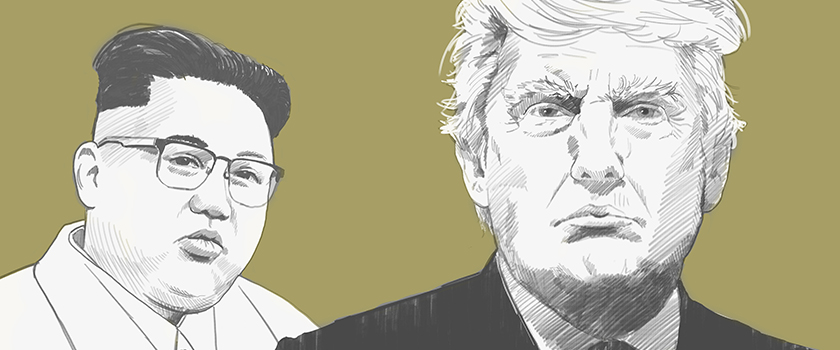Summary
- Tame market response to the summit is accurately priced, in our view, with still low expectations of a real breakthrough in the near term to trade the ‘peace dividend’ or ‘economic reconstruction’ themes.
- Best-case scenario will definitely reward South Korean assets but likely to be at the expense of Japan; JPY may face added structural depreciation pressure.
- Unification cost to South Korean economy is still unclear but it should not be as dire as the headline figure suggests.
- The worst-case scenario is extreme pessimism about policy flip-flops by both sides again leading to a higher risk of actual military conflict while markets re-price global geopolitical risk.
Despite it ending with warm words and vague promises yesterday, the Trump-Kim Summit released a lack-of-substance, one-and-a-half page joint- agreement which in practice provided little real insight on what was actually achieved. Arguably, this is roughly what the market had already priced in (given the tame responses in KOSPI, KRW, Korean rates and CDS in the run-up to and in the aftermath of the event), and seems appropriate in our view. At best, the summit should avoid imminent hostilities and marks a crucial first step for a likely long, drawn-out negotiation process for North Korea’s denuclearisation.
It seems an appropriate base case scenario for now where an actual breakthrough for an ending of economic sanctions on North Korea, the US military presence and an irreversible denuclearisation by Pyongyang are not yet risk-on bets on the ‘peace dividend’ in financial markets. And we all need to stay close to monitor the possible development that will follow keeping in mind the spectre of the two leaders’ highly unpredictable style of policymaking and announcements.
Further down the road, however, the tail risks (despite their small probability at this juncture) could have quite a binary outcome. The best case is that yesterday’s event indeed marks the acceleration in the peace agreement, denuclearisation and ultimate unification on the Korean peninsula.
Some may draw the optimistic analogy of the 1986 summit between Ronald Reagan and Mikhail Gorbachev that led to the INF (Intermediate-Range Nuclear Force) Treaty in 1987. The event had a longer-term impact on US military spending cuts in the 1990s (and, thus, its budgetary balance) as well as laying the foundations for the eventual break-up of the Eastern European block that unleashed massive cheap production capacity (along with China) to the global economy in the following two decades.
The Good
In Korea’s most optimistic case, we expect the following:
Economic sanctions to end swiftly followed by a joint US, China, South Korea-led economic reconstruction programme to pave the way for the eventual reunification of the North and South.
The ‘investment boom’ theme plays out on relevant South Korean and other foreign (particularly US and China) construction and infrastructure firms. The likely initial outcome will be the resumption of North Korea’s economic zones and rapid expansion thereafter with active foreign participation.
Japan would be seen as the immediate loser as South Korea - already gaining a considerable competitive edge over many Japanese technology and industrial firms in the global market - will amass even more global market share given the North’s cheaper production costs and natural resources. A structurally weaker JPY will be perceived as the inevitable economic outcome.
It is still difficult to assess the unification cost and immediate economic consequences for the South Korea economy as the unification aspiration develops. As a comparison, the merger of East and West Germany in 1990 was abrupt, and the low currency conversion rate caused rapid inflationary pressures that resulted in an immediate sell-off in the Bund. Of course, unification acted to change Bundesbank policy significantly thereafter.
Arguably, the current north-south divide in Korea is considerably more significant than the east-west income gap in Germany in 1990. The numbers bubbling around for Korea’s unification cost are estimated at US$2 trillion which is the size of South Korea’s annual GDP. It looks staggering but much less so if we consider the merger of the two economies will be part of a long-term process as compared to the rather abrupt change in Germany.
Indeed, South Korea’s persistent fiscal conservatism over the past two decades was a pre-emptive policy that has been far too well prepared for the eventual unification objective. The government’s balance sheet is strong and with reasonably low public debt (about 35% of GDP), and the potential for foreign aid and financial assistance, the funding requirement pressure should not be as severe as the headline number implies.
However, it is reasonable to expect upward pressure on South Korea’s domestic rates and yields on expanded liquidity demand, and downward depreciation pressure on KRW as the administration figures out the right conversion rate for a unified currency.
The Bad
The worst-case scenario is likely to be at the other end of extreme pessimism with a risk of the two leaders flipflopping again. The right spirit of the joint-agreement could completely unravel if a decision on the actual denuclearisation process never comes close. Trust between Trump and Kim can evaporate quickly, and the two sides are then unable to return to square one but instead step towards the path of true military confrontation.
Global markets will be seriously impacted by such a geopolitical event with global risk-off but JPY likely to strengthen in the search for safe haven trade. South Korea becomes the big loser with sovereign rating downgrades, asset sell-offs and investors accurately pricing the ‘North Korean’ premium in a way that has never seen before.
Anthony Chan
Chief Asia Investment Strategist

